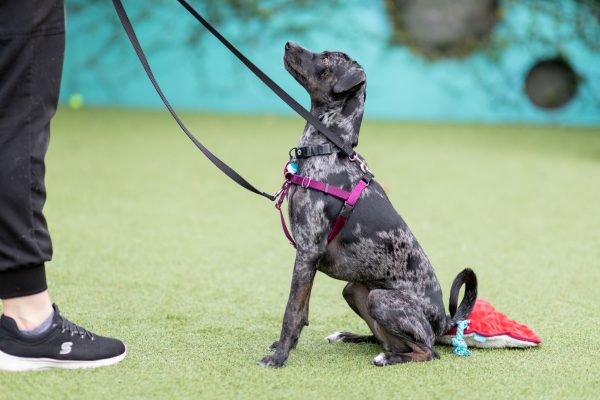Adopting a dog is a wonderful way to add love and joy to your life. But just like people, dogs need time to adjust when they enter a new environment. That’s where the 3-3-3 guideline comes in.
What is the 3-3-3 guideline?
The 3-3-3 guideline is a helpful guideline for bringing a rescue dog home and helping them settle in. This guideline splits this transition into three stages:
- The first 3 days are about adjusting to new surroundings.
- The next 3 weeks are for building a routine and starting to develop foundational skills through positive reinforcement training.
- The first 3 months are about deepening trust and building confidence through continued training.
Every dog is different, and not all dogs will follow this timeline exactly. The key is to be patient, give your dog space, and let them adjust at their own pace.
Why is the 3-3-3 guideline important?
Moving into a new home is a big change for a dog, especially one coming from a shelter. The 3-3-3 guideline helps you and your dog navigate this adjustment period. By keeping the 3-3-3 guideline in mind, you can:
- Set realistic expectations.
- Avoid overwhelming your dog with too much too soon.
- Help your dog feel safe, secure, and loved.
- Give your dog the best chance to become a happy, well-behaved member of your family.

The 3-3-3 guideline: what to expect
The first 3 days
Be patient and positive
What your dog is feeling:
Your new dog is decompressing and taking in their new world. They may feel scared, unsure, or overwhelmed. Imagine if you moved to a new city or started a new job. Everything would be unfamiliar, and you’d need some time to get settled. During this time, your dog might hide, avoid eye contact, or not eat much. These behaviors may be normal responses to fear and stress.
Tips for this stage:
- Provide a calm and quiet home environment to help set your dog up for success.
- Be gentle, speak softly, and focus on positive reinforcement instead of punishment.
- Create a safe space where your dog can seek comfort, like a crate, cozy bed, or separate room. Help your dog understand that this is their own space where they can rest uninterrupted. Note: Not all dogs need to be crate trained. If your dog is unable to relax in a crate, do not force them to do so.
- Avoid forcing attention, especially when your dog is adjusting to their new home. Instead, let them come to you and allow your dog to choose if they want to have interactions or not. As you spend time with your new dog, it’s important to learn your dog’s body language and understand their comfort level in different situations.

The next 3 weeks
Celebrate little wins
What your dog is feeling:
They’re starting to feel more comfortable and may begin showing their true personality. Some behavior challenges may pop up, like barking or chewing. While these behaviors can be normal as your dog adjusts, sometimes behavior changes can be a sign of a physical or behavioral disorder. If these behaviors are escalating or if you see other signs like decreased appetite, lethargy, social withdrawal, or vomiting, please see your veterinarian.
Tips for this stage:
- Start positive reinforcement training, ensuring your trainer uses rewards and does not use tools like shock or prong collars.
- Be patient and keep sessions short and fun.
- Provide ample daily enrichment opportunities. Different dogs will enjoy different activities, such as walks, off-leash play in a controlled outdoor setting, short training sessions, playing with toys, and enjoying long-lasting food-stuffed treats.

The first 3 months
Strengthen your bond and build trust
What your dog is feeling:
By now, your dog feels more at home. They’re starting to trust you and develop a routine. You’ll likely see their true personality shine through! This is the perfect time to continue building your bond.
Tips for this stage:
- Continue to provide ample enrichment opportunities as you learn more about your dog’s likes and needs.
- Keep training and interactions fun and consistent. Remain patient and don’t force your dog into situations that seem uncomfortable to them.
- Slowly introduce them to other pets and people. Try new experiences like car rides, park visits, or short trips.
- Celebrate progress, no matter how small.

Takeaways
Adopting a rescue dog is a rewarding experience, but it does take time, patience, and love. The 3-3-3 guideline is helpful for understanding your dog’s transition and helping them feel safe and secure in their new home.
Remember, not every dog will follow the 3-3-3 timeline perfectly. What matters most is that you’re there for your dog as they adjust to their new home. In all circumstances, monitor your dog’s comfort level and willingness to eat treats. If they seem uncomfortable or start refusing treats, this is a good indicator that they are not comfortable with the situation and should take a step back.
If you have questions or need help, don’t hesitate to reach out to our Adoptions team. And if you run into behavior challenges, our Behavior team is here to support you.
The San Francisco SPCA is with you every step of the way. Together, we can help your new dog feel loved, confident, and ready to thrive.
